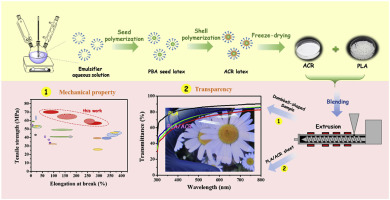当前位置:
X-MOL 学术
›
Compos. Sci. Technol.
›
论文详情
Our official English website, www.x-mol.net, welcomes your
feedback! (Note: you will need to create a separate account there.)
Core-shell nanoparticles toughened polylactide with excellent transparency and stiffness-toughness balance
Composites Science and Technology ( IF 8.3 ) Pub Date : 2018-08-01 , DOI: 10.1016/j.compscitech.2018.04.037 Yuan Chen , Mingwang Pan , Yue Li , Jia-Zhuang Xu , Gan-Ji Zhong , Xu Ji , Zheng Yan , Zhong-Ming Li
Composites Science and Technology ( IF 8.3 ) Pub Date : 2018-08-01 , DOI: 10.1016/j.compscitech.2018.04.037 Yuan Chen , Mingwang Pan , Yue Li , Jia-Zhuang Xu , Gan-Ji Zhong , Xu Ji , Zheng Yan , Zhong-Ming Li

|
Abstract Polylactide has attracted increasing focus on packaging and other consumer products nowadays, due to its stiffness, biodegradability and good transparency. However, its toughened blends are usually utilized to conquer its inherent brittleness, unfortunately, bringing with undesirable opaqueness. Considering the transparency and toughness of PLA, nanoparticles with core-shell structure, which are one kind of methyl methacrylate–butyl acrylate (ACR) copolymers whose rubbery cores resist impact and the glassy shells provide rigidity and compatibility to the polymer matrix, were manipulated by seed emulsion polymerization in this work, aiming to toughen PLA without the substantial decrease of transparency and tensile strength simultaneously. The effects of size and content of ACR nanoparticles on the optical properties, mechanical properties of PLA/ACR blends respectively were clarified. The PLA/ACR blends exhibited excellent transparent property with a transmittance as high as 75% (550 nm). We found an unexpected relationship between particles size and transparency, that is, with the decrease of ACR size, the transparency of blends was also reduced slightly. This phenomenon may contribute to the scattering of bigger aggregation formed by ACR with smaller size, which was identified by microstructure observations. Tensile testing showed the maximum elongation at break of 279.9% when ACR content reached 20 wt%, which was a 65-fold increase compared with neat PLA. Promisingly, the elastic modulus and tensile strength exhibited less decreased with the value of 55.7 MPa and 2.06 GPa respectively, and this blends displayed 8 times the Izod impact strength over neat PLA. It was revealed the shear yielding of matrix and cavitation of particles during the loading process led to the excellent toughness of PLA/ACR blends.
中文翻译:

核壳纳米粒子增韧聚乳酸,具有优异的透明度和刚度-韧性平衡
摘要 聚乳酸由于其刚性、生物降解性和良好的透明度,如今越来越受到包装和其他消费品的关注。然而,它的增韧混合物通常用于克服其固有的脆性,不幸的是,会带来不希望的不透明性。考虑到 PLA 的透明度和韧性,具有核壳结构的纳米粒子是一种甲基丙烯酸甲酯 - 丙烯酸丁酯 (ACR) 共聚物,其橡胶核抗冲击,玻璃壳为聚合物基体提供刚性和相容性,通过在这项工作中进行种子乳液聚合,旨在增韧 PLA 而同时不显着降低透明度和拉伸强度。ACR纳米颗粒的尺寸和含量对光学性能的影响,分别阐明了 PLA/ACR 共混物的力学性能。PLA/ACR 共混物表现出优异的透明性能,透光率高达 75% (550 nm)。我们发现粒径和透明度之间存在意想不到的关系,即随着 ACR 尺寸的减小,共混物的透明度也略有降低。这种现象可能有助于分散由 ACR 形成的较大聚集体,尺寸较小,这是通过微观结构观察确定的。拉伸试验表明,当 ACR 含量达到 20 wt% 时,最大断裂伸长率为 279.9%,与纯 PLA 相比增加了 65 倍。令人鼓舞的是,弹性模量和拉伸强度的下降幅度较小,分别为 55.7 MPa 和 2.06 GPa,这种共混物的 Izod 冲击强度是纯 PLA 的 8 倍。结果表明,加载过程中基体的剪切屈服和颗粒的空化导致 PLA/ACR 共混物具有优异的韧性。
更新日期:2018-08-01
中文翻译:

核壳纳米粒子增韧聚乳酸,具有优异的透明度和刚度-韧性平衡
摘要 聚乳酸由于其刚性、生物降解性和良好的透明度,如今越来越受到包装和其他消费品的关注。然而,它的增韧混合物通常用于克服其固有的脆性,不幸的是,会带来不希望的不透明性。考虑到 PLA 的透明度和韧性,具有核壳结构的纳米粒子是一种甲基丙烯酸甲酯 - 丙烯酸丁酯 (ACR) 共聚物,其橡胶核抗冲击,玻璃壳为聚合物基体提供刚性和相容性,通过在这项工作中进行种子乳液聚合,旨在增韧 PLA 而同时不显着降低透明度和拉伸强度。ACR纳米颗粒的尺寸和含量对光学性能的影响,分别阐明了 PLA/ACR 共混物的力学性能。PLA/ACR 共混物表现出优异的透明性能,透光率高达 75% (550 nm)。我们发现粒径和透明度之间存在意想不到的关系,即随着 ACR 尺寸的减小,共混物的透明度也略有降低。这种现象可能有助于分散由 ACR 形成的较大聚集体,尺寸较小,这是通过微观结构观察确定的。拉伸试验表明,当 ACR 含量达到 20 wt% 时,最大断裂伸长率为 279.9%,与纯 PLA 相比增加了 65 倍。令人鼓舞的是,弹性模量和拉伸强度的下降幅度较小,分别为 55.7 MPa 和 2.06 GPa,这种共混物的 Izod 冲击强度是纯 PLA 的 8 倍。结果表明,加载过程中基体的剪切屈服和颗粒的空化导致 PLA/ACR 共混物具有优异的韧性。











































 京公网安备 11010802027423号
京公网安备 11010802027423号